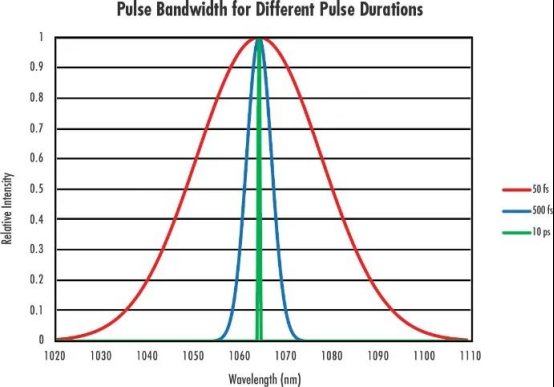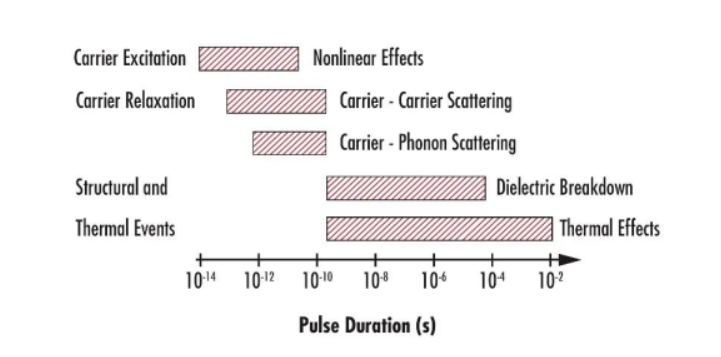Unique ultrafast laser part one
Unique properties of ultrafast lasers
The ultra-short pulse duration of ultrafast lasers gives these systems unique properties that distinguish them from long-pulse or continuous-wave (CW) lasers. In order to generate such a short pulse, a wide spectrum bandwidth is required. The pulse shape and central wavelength determine the minimum bandwidth required to generate pulses of a particular duration. Typically, this relationship is described in terms of the time-bandwidth product (TBP), which is derived from the uncertainty principle. The TBP of the Gaussian pulse is given by the following formula :TBPGaussian=ΔτΔν≈0.441
Δτ is the pulse duration and Δv is the frequency bandwidth. In essence, the equation shows that there is an inverse relationship between spectrum bandwidth and pulse duration, meaning that as the duration of the pulse decreases, the bandwidth required to generate that pulse increases. Figure 1 illustrates the minimum bandwidth required to support several different pulse durations.

Figure 1: Minimum spectral bandwidth required to support laser pulses of 10 ps (green), 500 fs (blue), and 50 fs (red)
The technical challenges of ultrafast lasers
The wide spectral bandwidth, peak power, and short pulse duration of ultrafast lasers must be properly managed in your system. Often, one of the simplest solutions to these challenges is the broad spectrum output of lasers. If you have primarily used longer pulse or continuous-wave lasers in the past, your existing stock of optical components may not be able to reflect or transmit the full bandwidth of ultrafast pulses.
Laser damage threshold
Ultrafast optics also have significantly different and more difficult to navigate laser damage thresholds (LDT) compared to more conventional laser sources. When optics are provided for nanosecond pulsed lasers, LDT values are usually in the order of 5-10 J/cm2. For ultrafast optics, values of this magnitude are practically unheard of, as LDT values are more likely to be on the order of <1 J/cm2, usually closer to 0.3 J/cm2. The significant variation of LDT amplitude under different pulse durations is the result of laser damage mechanism based on pulse durations. For nanosecond lasers or longer pulsed lasers, the main mechanism that causes damage is thermal heating. The coating and substrate materials of the optical devices absorb the incident photons and heat them. This can lead to distortion of the material’s crystal lattice. Thermal expansion, cracking, melting and lattice strain are the common thermal damage mechanisms of these laser sources.
However, for ultrafast lasers, the pulse duration itself is faster than the time scale of heat transfer from the laser to the material lattice, so the thermal effect is not the main cause of laser-induced damage. Instead, the peak power of the ultrafast laser transforms the damage mechanism into nonlinear processes such as multi-photon absorption and ionization. This is why it is not possible to simply narrow down the LDT rating of a nanosecond pulse to that of an ultrafast pulse, because the physical mechanism of damage is different. Therefore, under the same conditions of use (e.g., wavelength, pulse duration, and repetition rate), an optical device with a sufficiently high LDT rating will be the best optical device for your specific application. Optics tested under different conditions are not representative of the actual performance of the same optics in the system.

Figure 1:Mechanisms of laser induced damage with different pulse durations
Post time: Jun-24-2024





